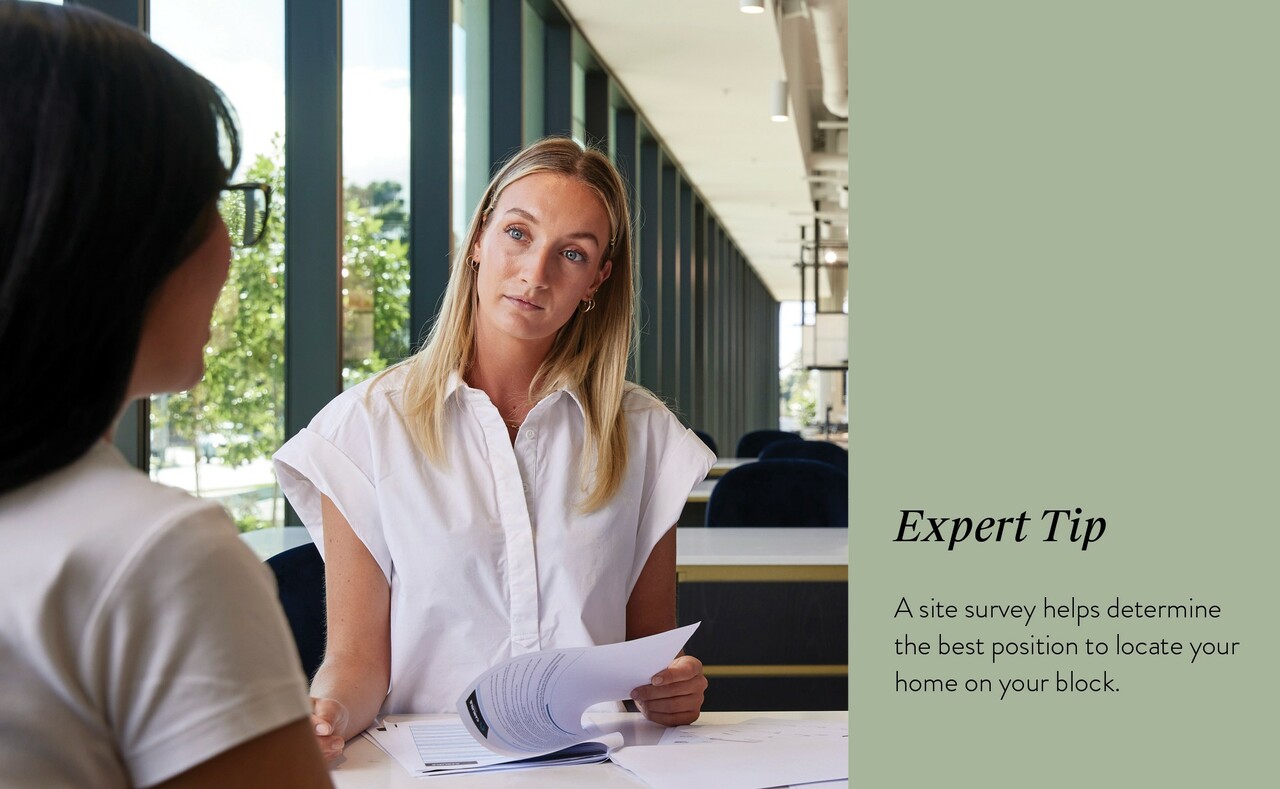Learn the Land Lingo

The home building journey is full of words and phrases you may not be familiar with, which can make the process seem overwhelming.
At Carlisle, we don’t want you to feel confused at any point in your building journey, that’s why we’ve put together this land lingo guide! You’ll find yourself talking the talk like a land professional in no time.
What is...
Certificate of title
A certificate of title is a legal document that identifies the owner/s of a block of land.
Title date or titled land
A block’s title date is the official date the block of land registers as an official address.

Bulk earthworks
A term used to describe when your developer has commenced construction on your land, and the stage your block is part of. Bulk earthworks will involve the developer importing fill as per the developer’s engineering plans, as well as removing any soil they plan to. This will go hand in hand with installing services to your stage, for example, the sewer and gas mains.
Statement of Compliance (SOC)
Once your stage earthworks are complete, the roads, kerb and channel are present, and your service mains are in, your lot will be eligible for a Statement of Compliance. This will be lodged with the council for approval in order to gain official titles.
Soil report
Conducted by a certified engineer, the purpose of the soil report is to get a detailed understanding of the site’s earth conditions, and how those conditions may impact the support and structure of your home. The outcome of your soil report will impact the type of foundation used for your home.
Site survey
A site survey is an examination of your land to establish the position of the proposed construction of your home. The survey identifies the correct orientation and positioning of the house, any obstacles that may need removal before construction, including large trees, and any easements that may burden or benefit your land or the construction of your home. The site survey also determines your land’s current elevation and slope levels in order to identify what site works will be required to create a level building platform.

Re-establishment survey
The purpose of a re-establishment survey is to reinstate the boundary of a block of land to determine exactly where your property’s boundary lines are.
Site costs
The expenses associated with your specific block of land in order to prepare your land for home construction, for example the slab, bored piers, and retaining walls. Unless your site costs are ‘fixed’* in, the price of these expenses will be based on the outcome of your site survey, and soil report.

Site costs means:
- Site preparation works: site fall/earthworks, rock removal, retaining walls and drainage.
- Engineering requirements: slab costs including upgrades, bored piers, additional reinforcements, and deepened beams.
- Council requirements: temporary fencing, timber footpath crossover.
- Developer requirements: façade treatments, roof pitches and fibre optics (excludes corner façade treatments for blocks situated on a corner, or any other developer requirements not listed).
Please refer to your Site Cost Guarantee document for further details.
Please note that site costs are separate to the owner’s obligation to provide a clear building site. Site costs do not include the costs associated with the removal of long grass, debris, and objects/contaminants concealed in the soil, or old and unused services and drainage.
Fixed site costs*
Fixed site costs are generally optional for clients and can be provided at the start of your sales journey. Fixed site costs remove the risk of any unforeseen costs that may pop up after your site survey or soil report. Your fixed site costs include all associated site costs, any OH&S requirements, council requirements, and developer guidelines.
Fill
Additional soil or materials imported onto your block that are used to level your land according to its elevation or slope, and prepare the block for home construction.
Fall
The amount of slope on your block. This slope is dictated by the developer’s engineering, and is what Carlisle will use to understand how much earthworks are required to create a flat building platform on your block.
Retaining wall
Timer sleepers or rendered brick ‘walls’ constructed within your property boundary to contain soil (fill). These retaining walls will be located at the front, side or rear of your block. Their volume and frequency will depend on the fall (slope) of your site.
Frontage
Frontage is the width of the front boundary of your block of land.
Depth
The measurement from the front point to the rear point of your block.
The frontage of your block multiplied by the depth of your block equals the overall size of your land.
Easements
Easements are a section of land registered on your title, generally to the rear or side of your block, used for services such as water, gas, and electricity. An easement permits a person or authority to use or access that part of your land to access services for any maintenance requirements.
Land rebate
An incentive the developer may put towards your block of land at settlement, for example $10k off the overall land price by way of a rebate. Carlisle Homes can help you understand these terms and conditions, and exactly how much you can save.
Stamp duty
The tax placed by the government on the legal transfer of assets, such as land, existing property, and cars.

Crossover
The point at which you access the street from your block. Once your home is complete, this will be the point where you place your driveway. It’s important to know where your crossover will be located, as this will impact the position and orientation of your home on your block.
You can find your crossover location on the Engineering Report issued by your land developer.
Developer engineering
An engineered plan of your lot, and the stage your lot is contained in, provided by a civil engineer on behalf of your estate’s developer. This plan shows the level of proposed fill for your block, as well as your blocks heights, indicating if the site if flat, or more inclined. This plan is crucial for your builder to understand how to design your slab, and what earthworks are required to promote a stable building platform.
Building envelope
A building envelope is the maximum space that your home can be built in on your block as determined by your land developer, including the width, length, and height of your home.
Plan Of Subdivision (POS)
A document proposed by your land developer, and approved by the relevant council authority, which shows your block and the others within your stage, with each applicable block’s area, frontage, and depth measurements. The POS also shows any restrictions to your block, for example where only double storey builds are allowed, and the location of the easement, plus its size and type, for example, a sewer.
Bushfire attack level (BAL)
A BAL rating is used to measure the potential risk of exposure to a bushfire. Any homes built in an area considered to be ‘bushfire prone’ will be given a BAL rating. This rating establishes the requirements for construction, ultimately to improve the protection of your home from attack by bushfire.

Council requirements
Your local council will have certain requirements that you must adhere to in order to be granted a building permit.
Developer requirements
Similar to your council requirements, you will also need to meet your land developer’s requirements if you’re building in a new estate. These requirements will often relate to visual/style requirements that your new home must meet to keep the look of the estate consistent, and provide an improved outcome for the community. Your home must meet these requirements in order to be granted developer approval.
Developer approval
If building in a new estate, you must be granted approval by your developer before you can begin construction of your home. Approval will be granted on the premise that all requirements (explained above) are met.
Developer stages
In new land estates, the land developer will divide the estate into smaller ‘stages’, and construction of these stages will occur at different times. Infrastructure construction will occur based on these stages. For example, completion of roads, crossovers, power, and water supply will all occur in the first stage of an estate, before moving on to the second.
If purchasing land still leaves you scratching your head in confusion, let us take the stress out of your decision with our House & Land packages. With hundreds of packages available, we can help you find the perfect fit (it’s all part of our commitment to making the building experience better in any way we can!) Click here to start your House & Land journey with Carlisle.
*FIXED PRICE: Price based on Developer supplied engineering plans and Plan of Subdivision; standard floor plan with preferred siting (without alterations), Carlisle’s recommended Building Surveyor and residential zoning at package date. Confirm land prices and availability prior to purchase. Subject to developer and council approval. Pricing also excludes features not supplied by Carlisle, including fencing, landscaping, planting, letterbox, decking and driveway. There is an exception to ‘Fixed site costs’ as Carlisle cannot include costs associated with Developer’s Corner Facade treatment requirements which require design work per house design (which will be priced individually for Carlisle Homes’ customers).
